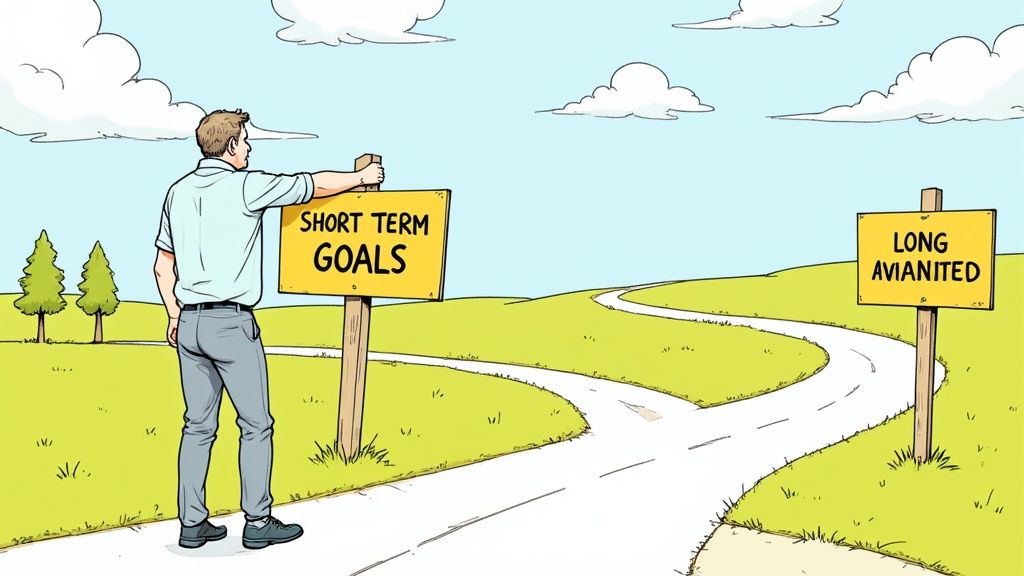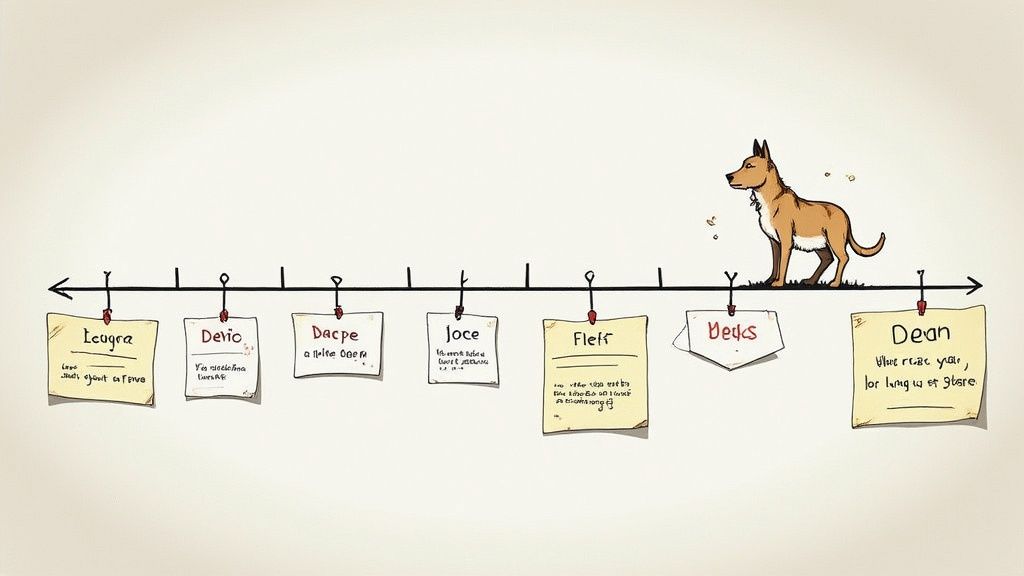Short and Long Term Goals: The Ultimate Guide to Strategic Achievement


Understanding the Power of Short and Long Term Goals

Creatng meaningful progres in life requres ballancing immedate action with futre vision. This ballance comes from combning short and long-term goals. Think of your long-term goal as your destnation, while short-term goals are the steps that move you foward each day.
Why Are Both Types of Goals Important?
Short-term goals give you quick wins and keep motivation high. They provide regular feedback to help adjust your approach when needed. For example, if you want to write a book (long-term), writing one chapter per week (short-term) makes the project manageable and less daunting.
Long-term goals provide direction and deeper meaning to your efforts. They represent your biggest dreams and give context to daily actions. Without this bigger picture, short-term achievements can feel random and disconnected. The key is making both types of goals work together.
Building a Goal Hierarchy
Creating a goal hierarchy helps connect your short and long term goals effectively. Start with your main long-term goal, then break it down into smaller milestones. Each short-term goal should help achieve the next level up, ultimately leading to your big-picture objective.
It's like building a house - the completed home is the long-term goal. The short-term goals are specific tasks: laying the foundation, building walls, adding the roof. Each phase builds on what came before.
Real-World Examples and Statistics
Take changing careers as an example. Your long-term goal might be becoming a project manager. Short-term goals could include getting certified, building your professional network, and gaining experience through volunteer work. Each step moves you closer to your target role.
A 2023 UK study found that people typically set three long-term and three short-term goals each, often focusing on finances. Read the full study. But setting goals isn't enough - you need to track progress, adapt plans when needed, and celebrate small wins. This keeps you moving forward while connecting daily actions to your bigger dreams.
Mastering Academic and Professional Goal Achievement
Setting clear goals is essential for success in both academic and professional life. Having well-defined objectives helps guide your decisions and ensures your daily actions contribute meaningfully to your larger ambitions. Research shows that people who set specific goals are up to 10 times more likely to succeed than those who take an unfocused approach.
Aligning Education With Long-Term Career Aspirations
Your education should serve as stepping stones toward your ultimate career goals. Each academic choice - from selecting a major to pursuing advanced credentials - needs to directly support your professional vision. For example, if you aim to work in software engineering, focusing on computer science coursework while also building practical skills through coding projects creates a strong foundation. The key is ensuring each educational step moves you closer to your target role.
Implementing Effective Goal-Setting Frameworks
Leading organizations rely on structured approaches to goal setting that include:
Regular progress check-ins
Mentorship programs
Skill development opportunities
Clear performance metrics
This systematic framework helps individuals stay focused on both immediate objectives and long-term growth. Purdue University Calumet highlighted this approach in their 1983-85 academic catalog, emphasizing goal setting as crucial for student success.
Creating a Dynamic Career Development Roadmap
Your career path requires flexibility while maintaining a consistent long-term vision. Consider these key elements:
Regular evaluation of progress
Seeking feedback from mentors
Adjusting short-term goals based on industry changes
Continuous skill development
Building professional relationships
By taking an active role in managing your career trajectory and remaining adaptable, you position yourself for sustained growth. The focus should be on making steady progress while being ready to adjust course when needed.
This balanced approach to goal setting and career planning helps create a solid foundation for ongoing professional achievement. Remember that success comes from consistent effort guided by clear objectives, not just talent alone.
Navigating Life Changes While Maintaining Goal Progress

Life often takes unexpected turns that require us to modify our plans. While circumstances may change, this doesn't mean abandoning your goals entirely. The key is being flexible while keeping your ultimate objectives in sight.
Adapting Your Goals, Not Abandoning Them
Understanding how to adjust goals is essential for long-term success. Think of it like taking a road trip - your destination remains the same, but you may need to take different routes due to road work or closures. These temporary changes represent modifications to your short-term approach while maintaining your bigger vision.
Consider this example: Your goal is to buy a house and you've planned to save a specific amount monthly. If you lose your job, you might need to temporarily reduce savings while focusing on finding new work. This isn't giving up on homeownership - it's simply adapting to current circumstances.
Goal Flexibility in the Face of Change
Major life events like career shifts, family changes, and health challenges each require unique approaches to goal adjustment. The key is maintaining resilience and a positive outlook. View obstacles as chances to learn and improve your strategy.
Research shows that adapting goals is particularly important when dealing with health conditions like cancer, stroke, or neurological issues. Studies reveal that 58% of research in this area demonstrates a clear link between goal adjustment and successful recovery. Read the full research.
Maintaining Motivation Through Challenges
Staying driven during difficult periods is crucial for progress. Break down larger goals into smaller, achievable mini-milestones. These small wins build confidence and momentum, even during setbacks. Building a support network of friends, family, and mentors provides encouragement and perspective when times get tough. Remember to acknowledge and celebrate each step forward, as these victories strengthen your commitment to your goals.
Building Your Goal Achievement System

Turning your goals from ideas into real accomplishments requires structure and planning. Whether you prefer traditional methods or digital tools, having a clear system is essential for steady progress toward your objectives.
Creating Meaningful Milestones and Review Cycles
Breaking down big goals into smaller milestones makes them more manageable and helps track progress. For example, if you want to run a marathon, start by training for a 5K race as your first milestone.
Regular progress reviews are key to staying on track. Set up weekly or monthly check-ins to assess how you're doing and make adjustments as needed. These reviews help ensure you're moving in the right direction and maintaining momentum.
Designing Accountability Systems and Productivity Tools
Having accountability partners significantly improves your chances of success. Consider:
Finding an accountability buddy
Joining a goal-focused group
Working with a coach or mentor
Sharing goals with trusted friends
The right tools can make goal tracking simpler. Use basic apps for tasks and scheduling, or try dedicated goal-tracking software like Strides or Way of Life. Pick tools that match your needs and help you stay organized.
Building Effective Feedback Loops and Measuring Progress
Regular feedback helps you improve continuously. Take time to reflect on what's working and what isn't. When something isn't getting results, be willing to try new approaches.
Track your progress with concrete metrics like:
Number of tasks completed
Time spent practicing
Progress toward milestones
Key performance indicators
Use charts or progress bars to visualize your achievements. Seeing your progress builds confidence and motivation. By combining clear tracking with consistent feedback, you create a powerful system for turning your goals into reality.
Harmonizing Multiple Goals Across Your Life
Managing multiple goals across different areas of life requires careful planning and coordination. Just like conducting an orchestra, each element needs to play its part for everything to come together smoothly. Having a clear understanding of how your personal, professional and health goals interact helps create alignment.
Identifying Goal Synergies and Conflicts
Begin by mapping out your short and long-term goals for each life area. Look for natural connections - for example, learning a new language could support both career advancement and personal travel aspirations. Be mindful of potential conflicts too. An intensive work project might make it harder to spend quality time with family. Spotting these tensions early lets you develop strategies to handle them effectively.
Resource Allocation and Time Management
Successfully pursuing multiple goals requires smart allocation of your two most precious resources - time and energy. Evaluate goals based on importance and urgency to set clear priorities. This often means making tough choices about where to focus. If advancing your career is the top priority right now, you may need to temporarily scale back other activities. Tools like time blocking can help optimize your daily schedule.
Maintaining Momentum and Energy Distribution
Like running a marathon, pursuing multiple goals requires pacing yourself for the long haul. Focus on 2-3 key priorities at a time to avoid spreading yourself too thin. Take time to celebrate small wins that show progress. Pay attention to your energy levels and make space for rest and recovery. Simple habits like regular breaks, good nutrition, and mindfulness help sustain motivation over time.
Creating a Sustainable Balance
Finding balance between multiple goals is an ongoing process of review and adjustment. Life circumstances change, so your approach needs to stay flexible. Regular check-ins help ensure your daily actions still align with your bigger vision. The key is being strategic about where you invest your energy, not trying to divide time perfectly between everything. Focus on what matters most to create meaningful progress across all areas of life.
From Vision to Victory: Implementing Your Goal Strategy

Once you've set clear short and long term goals, it's time to turn those plans into reality. Here's a practical guide to help you bridge the gap between planning and execution, ensuring your daily actions align with your bigger vision.
Turning Goals Into Action Steps
Start by creating a specific action plan. Break down your long-term goals into smaller, manageable tasks that serve as short-term goals. For example, if you aim to start a business, make completing a business plan within three months your first target. This approach makes big goals feel more achievable and helps track progress.
Handling Setbacks While Staying Motivated
Every goal journey includes obstacles. The key is building resilience and seeing challenges as chances to learn and grow. Keep your motivation strong by celebrating small wins along the way. These victories, like mastering basic phrases when learning a new language, provide encouragement and energy to keep moving forward.
Creating Forward Momentum
Early wins, even small ones, build confidence and establish good habits. Focus on achieving concrete progress you can measure - completing a difficult task, meeting a deadline, or learning something new. These accomplishments create positive momentum that helps sustain your drive during tough periods.
Measuring Progress and Recognizing Success
Use a tracking system that fits your style, whether it's a simple checklist or a dedicated app. Review your progress regularly and adjust your short-term goals when needed. Take time to acknowledge and celebrate reaching milestones. This reinforces positive actions and gives you chances to reflect and refine your approach.
Taking Concrete Action
Set clear deadlines and specific action steps for each short-term goal. Being detailed makes it easier to stay focused and measure results. Review your plans regularly to ensure they support your main objectives. Stay flexible and ready to adapt based on what works and what doesn't. This practical approach of planning, doing, and adjusting improves your chances of lasting success.
Ready to grow your coaching business? Coaching Hub provides tools and insights to help you succeed. Visit us today to learn how we can support your journey.